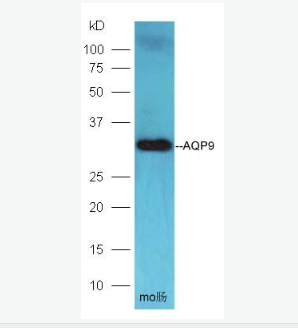| 中文名稱 | 水通道蛋白-9抗體 |
| 別 名 | aquaporin Protein-9; Aquaporin 9; AQP 9; AQP9; Aquaporin9; HsT 17287; HsT17287; Small solute channel 1; SSC 1; SSC1; Aquaporin-9; AQP-9; Aquaglyceroporin-9; AQP9_HUMAN. |
抗體來源 Rabbit
克隆類型 Polyclonal
交叉反應(yīng) Human, Mouse, (predicted: Rat, Dog, Pig, Cow, Rabbit, Sheep, Guinea Pig, )
產(chǎn)品應(yīng)用 WB=1:500-2000 ELISA=1:500-1000 Flow-Cyt=1μg /test
not yet tested in other applications.
optimal dilutions/concentrations should be determined by the end user.
分 子 量 32kDa
細(xì)胞定位 細(xì)胞膜
性 狀 Liquid
濃 度 1mg/ml
免 疫 原 KLH conjugated synthetic peptide derived from human AQP9:201-295/295
亞 型 IgG
純化方法 affinity purified by Protein A
儲 存 液 0.01M TBS(pH7.4) with 1% BSA, 0.03% Proclin300 and 50% Glycerol.
保存條件 Shipped at 4℃. Store at -20 °C for one year. Avoid repeated freeze/thaw cycles.
PubMed PubMed
產(chǎn)品介紹 Water is a critical component of all living cells. Interestingly, tissue membranes show a great degree of water permeability. Mammalian red cells, renal proximal tubules, and descending thin limb of Henle are extraordinarily permeable to water. Water crosses hydrophobic plasma membranes either by simple diffusion or through a facilitative transport mechanism mediated by special protein "aquaporin". A new member of AQP family, Aquaporin-9 (AQP9), has been cloned from human leukocytes by homology cloning (Ishibashi et al. 1997). It is mostly homologous with AQP3 and AQP7 (54-48% identity). AQP9 (295 AA) is primarily expressed in peripheral leukocytes, and lesser amounts in liver, lung and spleen. AQP9 is permeable to water and urea. Unlike AQP3 and AQP7, it did not facilitate glycerol transport. AQP families of proteins are predicted to contain six transmembrane domains. The N and C-terminus are predicted to be cytoplasmic. A new member of the AQP family, AQP9, has been cloned from human leukocytes. It is homologous with AQP3 and AQP7 (54-48% identity). AQP9 (295aa) is primarily expressed in peripheral leukocytes, and in lesser amounts in liver, lung and spleen. AQP9 is permeable to water and urea. Unlike AQP3 and AQP7, it does not facilitate glycerol transport. AQP families of proteins are predicted to contain six transmembrane domains. The N and C-terminus are predicted to b
| 產(chǎn)品圖片 | 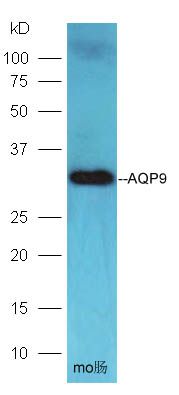 Sample:Intestinal(Mouse) lysate at 30 ug Primary: Anti-AQP9 (bs-2060R) at 1:300 dilution; Secondary: HRP conjugated Goat-Anti-Rabbit IgG(bse-0295G-HRP) at 1: 5000 dilution; Predicted band size : 32 kD Observed band size : 32 kD 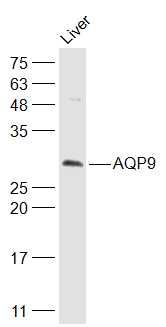 Sample: Liver (Mouse) Lysate at 40 ug Primary: Anti-AQP9 (bs-2060R) at 1/1000 dilution Secondary: IRDye800CW Goat Anti-Rabbit IgG at 1/20000 dilution Predicted band size: 32 kD Observed band size: 32 kD 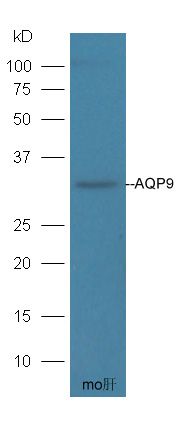 Sample:Liver(Mouse) lysate at 30 ug Primary: Anti-AQP9 (bs-2060R) at 1:300 dilution; Secondary: HRP conjugated Goat-Anti-Rabbit IgG(bs-0295G-HRP) at 1: 5000 dilution; Predicted band size : 32 kD Observed band size : 32 kD 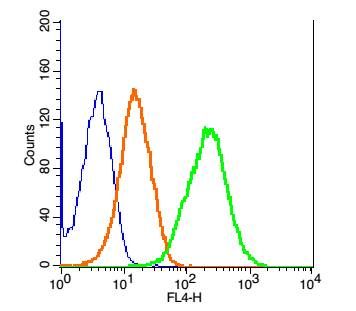 Blank control: A549(blue). Primary Antibody: Rabbit Anti- AQP9/AF647 Conjugated antibody (bs-2060R /AF647), Dilution: 1μg in 100 μL 1X PBS containing 0.5% BSA; Isotype Control Antibody: Rabbit IgG/AF647(orange) ,used under the same conditions. Protocol The cells were fixed with 2% paraformaldehyde (10 min) . The cells were washed twice with 1 X PBS. The cells were incubated in 1 X PBS containing 0.5% BSA + 1 0% goat serum (15 min) to block non-specific protein-protein interactions followed by the incubated with antibody (bs-2060R/AF647, 1μg /1x10^6 cells) for 30 min on ice. Acquisition of 20,000 events was performed. |


